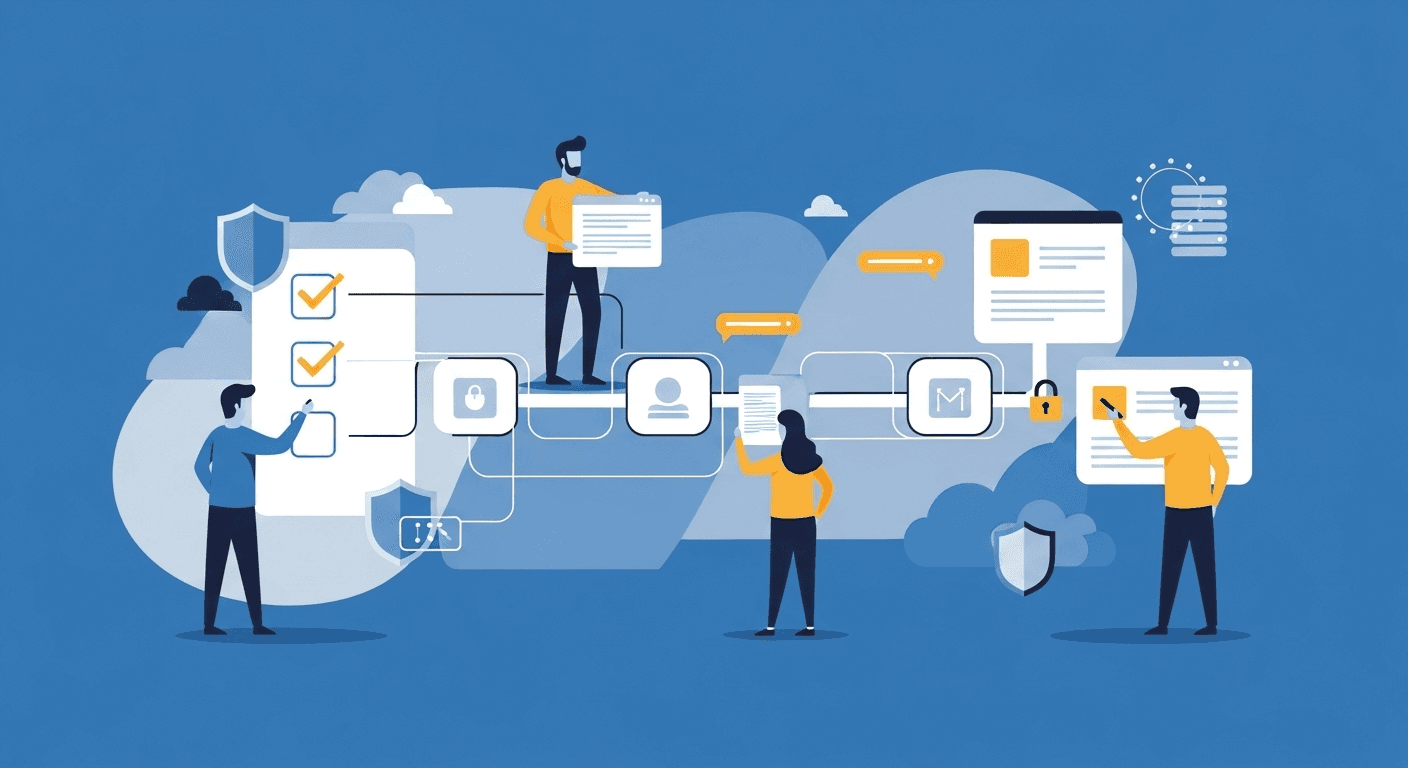GDPR Territorial Scope: When Does It Apply to Your Business? (Complete 2025 Guide)
Determine if GDPR applies to your business with this definitive guide to territorial scope. Learn the three key triggers, review real-world scenarios, and discover what steps to take once GDPR compliance becomes mandatory for your company.
Here's the question I hear most often from business owners: "Does GDPR actually apply to my company?" It's not surprising—GDPR's territorial scope can seem confusing at first glance. But here's the thing: understanding when GDPR applies isn't just academic. Get it wrong, and you could face fines up to €20 million or 4% of annual turnover.
The good news? GDPR's territorial scope follows clear, logical rules. Once you understand the three key triggers, you'll know exactly where your business stands. Let me walk you through everything you need to know.
Understanding GDPR's Territorial Scope: The Foundation
GDPR doesn't just apply to European companies—that's the first misconception to clear up. The regulation follows what lawyers call "extraterritorial application," meaning it can reach businesses anywhere in the world under specific circumstances.
Think of GDPR's territorial scope like a fishing net. It doesn't matter where your boat (business) is anchored—if you're fishing in EU waters (processing EU residents' data), you're subject to EU fishing regulations (GDPR).
This approach reflects the EU's commitment to protecting its residents' data rights, regardless of where the processing actually happens. It's a fundamental shift from traditional regulatory thinking, and it's why so many non-EU businesses find themselves needing GDPR compliance.
The Three Triggers: When GDPR Definitely Applies to Your Business
GDPR Article 3 establishes three clear scenarios where the regulation applies. Let me break each one down:
Trigger 1: Establishment in the EU
If your business has an "establishment" in the EU, GDPR applies to all your processing activities—even those that happen outside the EU.
An establishment doesn't just mean a headquarters. It includes:
- Branch offices or subsidiaries
- Sales offices or customer service centers
- Employees working remotely from EU locations
- Even a single employee conducting business activities in the EU
I recently worked with a US software company that thought they were exempt from GDPR. They discovered their customer success manager working from Berlin made them subject to the regulation for all their data processing activities.
Trigger 2: Offering Goods or Services to EU Residents
This is where many businesses get caught off guard. You don't need a physical presence in the EU—if you're actively targeting EU residents with goods or services, GDPR applies.
Key indicators that you're "offering" to EU residents include:
- Website content in EU languages
- Accepting EU currencies or payment methods
- EU-specific marketing campaigns
- Shipping to EU addresses
- EU phone numbers or addresses listed
The crucial word here is "offering." Simply being accessible from the EU isn't enough—there must be clear intent to serve EU customers.
Trigger 3: Monitoring EU Residents' Behavior
If you track, profile, or monitor the behavior of people in the EU, GDPR applies—regardless of whether they're your customers.
Common monitoring activities include:
- Website analytics and tracking cookies
- Behavioral advertising and retargeting
- Location tracking through mobile apps
- Social media monitoring
- Email tracking and engagement metrics
This trigger catches many businesses by surprise. Even if you're not selling to EU residents, using Google Analytics on a website accessible from the EU could trigger GDPR obligations.
Real-World Scenarios: Does GDPR Apply to These Businesses?
Let me walk through some real scenarios I've encountered to help clarify when GDPR applies:
Scenario 1: US E-commerce Store A California-based online retailer sells handmade jewelry. Their website is in English only, prices in USD, and they don't ship internationally. However, they use Google Analytics and Facebook Pixel.
GDPR Status: Applies - The tracking technologies monitor EU visitors' behavior, triggering GDPR obligations.
Scenario 2: Canadian SaaS Company A Toronto software company offers project management tools. They have customers worldwide, including some in Germany and France who found them through organic search.
GDPR Status: Applies - They're offering services to EU residents, even if not actively targeting them.
Scenario 3: Australian Consulting Firm A Sydney-based business consultant works exclusively with Australian companies. No EU customers, no EU marketing, no tracking beyond basic server logs.
GDPR Status: Doesn't Apply - No establishment, offering, or monitoring activities related to the EU.
Scenario 4: UK Company Post-Brexit A London-based fintech startup serves customers across Europe and uses advanced analytics to personalize user experiences.
GDPR Status: Applies - Post-Brexit, UK companies are treated like any other non-EU business, but they're clearly offering services to EU residents.
Common Misconceptions About GDPR Territorial Scope
Over the years, I've heard these misconceptions repeatedly. Let me set the record straight:
Myth 1: "We're not a European company, so GDPR doesn't apply" Wrong. Location of your business doesn't determine GDPR applicability—your activities do.
Myth 2: "We only have a few EU customers, so we're exempt" There's no minimum threshold. One EU customer can trigger full GDPR obligations.
Myth 3: "We blocked EU IP addresses, so we're safe" IP blocking isn't foolproof and doesn't address existing EU customer data you may have processed.
Myth 4: "We use a US cloud provider, so US law applies" The location of your data processing infrastructure doesn't determine which privacy laws apply to your business activities.
Myth 5: "B2B companies don't need to worry about GDPR" GDPR applies to all personal data processing, including employee data, business contacts, and customer information in B2B contexts.
What to Do Once You Determine GDPR Applies
If you've determined that GDPR applies to your business, don't panic. Here's your action plan:
Step 1: Conduct a Data Audit
Map what personal data you collect, where it's stored, how it's processed, and who has access. This forms the foundation of your compliance program.
Step 2: Establish Your Legal Basis
For each type of data processing, identify your lawful basis under GDPR Article 6. This isn't optional—it's a fundamental requirement.
Step 3: Update Your Documentation
You'll need several key documents:
- Privacy policy that meets GDPR requirements
- Cookie policy for website tracking
- Data processing records (ROPA) if you have 250+ employees
- Data processing agreements with vendors
Our complete GDPR compliance checklist walks through all 50+ requirements in detail.
Step 4: Implement Individual Rights Procedures
EU residents have specific rights under GDPR, including access, deletion, and portability. You need processes to handle these requests within required timeframes.
Step 5: Set Up Breach Response Procedures
GDPR requires breach notification to authorities within 72 hours. Having a response plan ready is crucial.
Step 6: Consider a Data Protection Impact Assessment
If your processing activities pose high risks to individuals' rights, you may need a DPIA before starting processing.
Staying Compliant as Your Business Grows
GDPR compliance isn't a one-time checkbox—it evolves with your business. Here's what to monitor:
Geographic Expansion: Entering new markets may trigger additional privacy law obligations beyond GDPR.
New Processing Activities: Each new way you collect or use personal data requires legal basis analysis and potentially updated documentation.
Technology Changes: New tools, analytics platforms, or marketing technologies can change your compliance obligations.
Regulatory Updates: Privacy laws continue evolving. The EU regularly issues new guidance that affects compliance requirements.
I recommend reviewing your GDPR compliance quarterly, especially if you're a growing business. What starts as simple website analytics can quickly evolve into complex customer profiling that requires additional safeguards.
The Bottom Line on GDPR Territorial Scope
Understanding GDPR's territorial scope isn't just about avoiding fines—it's about building a sustainable, trustworthy business in our interconnected world. The regulation's extraterritorial reach reflects a global shift toward stronger privacy protection.
If any of the three triggers apply to your business—EU establishment, offering goods/services to EU residents, or monitoring EU behavior—GDPR compliance becomes mandatory. The key is acting proactively rather than reactively.
Remember, GDPR compliance doesn't have to be overwhelming. With the right approach and tools, you can build privacy protection into your business operations without derailing your growth plans.
The most successful businesses I work with view GDPR compliance as a competitive advantage. They use it to build customer trust, streamline their data practices, and position themselves as responsible stewards of personal information.
Ready to tackle GDPR compliance? Don't let territorial scope confusion hold your business back. PrivacyForge's AI-powered platform generates all your GDPR documentation in minutes, not months. From privacy policies to data processing records, we make compliance simple without cutting corners. Start today and join hundreds of businesses who've streamlined their privacy compliance with PrivacyForge.
Related Articles
Ready to get started?
Generate legally compliant privacy documentation in minutes with our AI-powered tool.
Get Started Today

